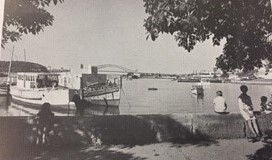For my major project this semester I have been working with the Balmain Institute. The Balmain Institute is a not for profit organisation which hosts public talks and discussions on topics such as the arts, science, economics, health, education, governance, the environment and current affairs. Established in 2010, the Balmain Institute has links to the former Balmain Workingmen’s Institute, which from 1863 provided the residents of Balmain with intellectual stimulation, opportunities for self-education, recreation and companionship. Furthermore, the original Balmain Workingmen’s Institute saw the suburb of Balmain transform from a blue-collar area to a gentrified, predominately middle-class suburb.
I chose to work with the Balmain Institute because of its relationship with the local community. The majority of the members of the Balmain Institute are long-term residents of Balmain and its surrounding suburbs, who are passionate about its history and its strong links to the early history of Sydney. When I think about what I love about history, it is the stories that have been hidden in plain view around us. Working with the Balmain Institute this semester has been an opportunity to shine a light on these stories, bring Balmain’s history out of the books and help the Balmain Institute to introduce a new, younger audience to their organisation and work and hopefully continue it into the future.
When I first made contact with the Balmain Institute, the organisation was very interested in me working with them. Initially suggesting I undertake a project looking at how the suburb had physically transformed over time, the project has expanded as I have done my research. Whilst there are numerous secondary sources about Balmain written by local historians, few of these can be found online. Additionally, Balmain’s oral histories are becoming less accessible as long-term residents age and the demographic of Balmain changes as a result of gentrification. Due to membership of the Balmain Institute primarily being people from the older generations who use print resources and a lack of dedicated funds, the organisation’s local historical sources online are lagging behind other organisations and institutions such as local history resources accessible through the State Library of New South Wales and municipal libraries. Therefore, it is the younger ‘online’ generation that is missing out on the stories which surround us.
The aim of this project is to compare how Balmain has physically transformed over time through maps from different time periods and link them to the memories and stories held by residents of the suburb, thus revealing what living in Balmain means to the local community. The project also examines how history can be preserved and communicated in ways other than traditional, printed history. Drawing on local history books, the Leichhardt Historical Journal, and the personal stories of some of Balmain’s residents, the aim is to reveal to others, particularly the younger generations, the depth of history they are surrounded by. The project also serves as a marketing campaign for the Balmain Institute by attracting new members of the organisation. The long-term goal is for younger residents and new residents of Balmain to learn about our local history, share their own stories and encourage them to engage with their local community through organisations such as the Balmain Institute.
I chose to present my research through the website ‘Balmain: Out of the Books’. A website is an easy and accessible way for people to access information and learn about the stories that have shaped a community. Inspired by other community history websites such as ‘Talk About Place’ (http://talkaboutplace.com/) and ‘Philaplace’ (http://www.philaplace.org/) which look at how a community is shaped by its residents and their history whether it be small actions or big historical moments; the aim was to create an ‘unending dialogue between the past and present’. The first page of the website or ‘Mapping Balmain’ looks at how Balmain has physically transformed over time. Using maps drawn by local historians and drawing inspiration from the book ‘Murs et Mémoire: la construction de Paris’ I drew my own maps to reveal changes to the suburb over the last 150 years. I also provided some information about these land settlements, particularly in the nineteenth century. On the page ‘Memories’ I used mapping software to pinpoint stories, memories and interesting facts about the history of Balmain. The next page, ‘Then and Now’ compares historic photographs of Balmain with modern photographs that I took. I have grown up being fascinated by these photographs and this project was an amazing opportunity to be able to show this rich resource off. Finally, I also included a contact form in which other residents can submit their own memories to the website. I plan to upload these stories as I receive more and more. I have also been using social media to create an online following of the website. I have set up both a Facebook page for ‘Balmain: Out of the Books’ as well as an Instagram page, which Inner West Council has started following.
I recently had a meeting with Dr Margaret Vickers, my original contact from the Balmain Institute, where we discussed the sustainability of the website ‘Balmain: Out of the Books’. Now the website is live, the Balmain Institute will notify its members about it in its monthly newsletter. The Institute will also post about the page on its various social media pages. Next year, the Institute is planning for me to give a talk at one of their monthly seminars about the project. I am also planning to put some flyers on the community noticeboard and possibly talk to local schools about the project, thus expanding the project even more.
Working with the Balmain Institute and creating this website over the past four months has been such a pleasure. I hope that ‘Balmain: Out of the Books’ will be a useful resource for not only the Balmain Institute in years to come, but also a source of intellectual stimulation and something that evokes a sense of belonging amongst Balmain’s resident’s past, present and future, just as the Institute has done since 1863.
https://www.balmainoutofthebooks.com/
Facebook: https://www.facebook.com/Balmain-Out-of-the-Books-776048262787598/

Author: eker6179
‘A Mind to Change’
When I think about what I love about history, it’s the stories that have been hidden in plain view around us. Growing up in Balmain I have always been fascinated with the suburb’s history. From photographs and maps, to stories of Aboriginal people driving kangaroos down through the suburb for food, and children sneaking through the Balmain East’s underground tram weight, local histories have always intrigued me and captured my imagination.
The Balmain Institute is a not for profit organisation that hosts public talks and discussions on topics such as science, arts, health, education, governance, economics and the environment. Established in 2010, the Balmain Institute has links to the former Balmain Workingmen’s Institute. From 1863, the Institute provided Balmain residents with intellectual stimulation, recreation and companionship throughout the years. Furthermore, the original Balmain Workingmen’s Institute saw Balmain transform from a blue-collar area to a gentrified, predominately middle-class suburb.
Last Thursday I attended the Balmain Institute’s monthly seminar. Feeling quite nervous, I was pleasantly surprised to find a friendly group of about 50 Balmain locals. All from different walks of life, these people were here to listen and learn. This month’s speaker was Dean Parkin, the Executive Director of the Uluru Education Project, which aims to drive awareness of the Uluru Statement from Heart.
After speaking with Margaret Vickers, Treasurer of the Institute, we began to develop an idea for the project. Looking at maps of the suburb, I will produce a project that will chart how the suburb has developed since it was established in 1836. Taking inspiration from the websites ‘Digital Harlem: Everyday Life 1915-1930’, and ‘Phila-place: Sharing Stories from the City of Neighbourhoods’, I will use the Leichhardt Historical Journal and the numerous maps of the suburb to develop a website showing the changing nature of the suburb. Drawing on the stories of local residents, shopkeepers and locals, I hope to create a project that will be useful for not only the Balmain Institute but also Balmain’s resident past, present and future.

